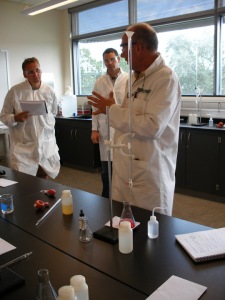Back in May, I attended a wine conference and listened to a lecture about testing the level of acid in wine. At the end of the lecture, the presenter gave a demonstration of how to use basic laboratory equipment to do it, but I was unfortunately sitting in the back, and the demonstration was not projected nor was the presenter elevated on a stage. It was very frustrating to me.
Well, this last week at my cider class with Peter Mitchell was much much better.
Mitchell went though and talked about pH and how ciders between the pH of 3.2 to 3.8 taste better and are less likely to develop infections, with the ideal pH around 3.5. We then got to test apple juice for pH using the strips that I use and also an expensive pH meter.
From there, Mitchell talked about the total acid content in the juice, and gave a demonstration at a small laboratory station on the technique used. The idea behind it was that if the pH was too high, the acid content would be too low since the more acid there is, the lower the pH would become. By testing the total acid, one could make a calculation of how much malic acid, the primary acid found in apples, to add to lower the pH.
pH is also important when working with sulfites. Sulfites have been used since ancient times when water with sulfur was probably used for cleaning and discoveries of how little infections would set in. The thing is, the lower the pH and the more acid that is present, the less sulfite is needed to prevent infections. To add more sulfites would just be a waste of money.
So after we found out our pH, we added sulfites based on our findings. Thing is, sulfer disappates after time, and some people are allergic to it so there are government regulations of how much can be present in cider, so tests need to be run to insure the cider does not become infected while not harming people. Once again, I actually got to run this experiment in the lab. Got to love hands on experience!
Mitchell recommended using the book Chemical Analysis of Grapes and Wine: Techniques and Concepts published in 2004 as a guide to help set up a cider lab.






No comments:
Post a Comment